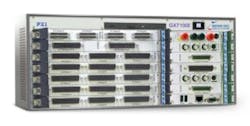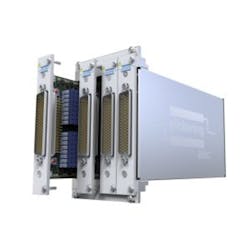AUTOTESTCON gets underway September 11 in Schaumburg, IL, with Monday tutorials covering “Automatic Testing from A to Z,” “Diagnostics and Design for Built-In Test,” ATE and TPS Management,” and “VXI, PXI, LXI, and AXIe Standards.” Exhibits open Tuesday, with companies planning to highlight products and technologies as outlined in our September cover story on military/aerospace test. Since that issue went to press, companies including Marvin Test Solutions and Pickering Interfaces have introduced new products or elaborated on their plans for the show, and JTAG Technologies has announced what products it will be presenting.
For example, Marvin Test Solutions announced Thursday the expansion of its PXI Express (PXIe) product portfolio with the introduction of three new PXIe chassis. The chassis offer a combination of PXIe, hybrid slots, and PXI-1, allowing users to configure a combination of resources for general-purpose as well as high-bandwidth test applications.
Like the company’s other PXI chassis, all three support integral smart functions including system power supply, slot temperature, and fan speed control/monitoring as well as PXI trigger mapping.
“These new additions to our PXI Express product portfolio provide the advanced features and capabilities that our customers look for when designing a modular and scalable test system, “ said Steve Sargeant, Marvin Test Solutions’ CEO. “The flexibility and open architecture of PXI and PXI Express make it possible to configure the right system for today’s requirements, and to upgrade and add resources when new requirements emerge.”
In addition, the company said, its GX7205 and GX7215 models are high-power chassis that are part of the GX7200 Series; they feature a 4×4 PXIe lane architecture with 21 slots, accommodating up to 20 instruments plus a single-slot controller. The GX7200 Series chassis support both external and embedded controller configurations. The GX7205 and GX715 feature a 1,400-W system power supply for high-power, high-performance applications and the cooling necessary to dissipate the additional heat.
PXI switch matrix modules
Meanwhile, Pickering Interfaces said Thursday that it would introduce a new BRIC Ultra-High-Density Large PXI Matrix Range at AUTOTESTCON. The Model 40-559 modules are robust 1-A/20-W switching modules with up to 4,096 crosspoints. The matrices are available in 2-, 4-, or 8-slot PXI sizes and are designed for high-performance matrix requirements.
With their high level of switching density, these PXI matrices allow a complete functional ATE system to be housed in a single 3U PXI chassis and allow the use of much lower cost 8- or 14-slot PXI chassis.
The matrices are designed with built-in high-performance screened analog busing to minimize the cost and complexity of cable assemblies to the device under test as well as to instrumentation.
The range includes Pickering’s Built-in Relay Self-Test (BIRST) and is also supported by the company’s eBIRST switching-system test tools. These tools provide a quick and simple way of finding relay failures within the modules.
The 40-559 matrices can be used in many industries; however, typical applications include automotive ECU and semiconductor package testing.
Boundary-scan tools
And finally, JTAG Technologies said it will demonstrate several boundary-scan solutions for the avionics clientele attending AUTOTESTCON this year.
For example, the JT 2147/eDAK multifunction signal-conditioning module is a test-hardware interface product compatible with the MAC Panel mass-interconnect system. The module allows “ideal world” connections from JTAG Technologies PXI and PXIe DataBlasters to the MAC Panel SCOUT connection system. Based on the QuadPod architecture from JTAG Technologies, the JT 2147/eDAK is an enhancement of JTAG’s current DAK interface and has been specifically designed for robust high-integrity ATE systems.
In addition, The JT 2147/VPC is a signal-conditioning module that allows “ideal world” connections from JTAG Technologies’ PXI and PXIe DataBlasters to the Virginia Panel Corp. connection system. Based on the QuadPod architecture from JTAG Technologies, the JT 2147/VPC has been specifically designed for connection into G20x or G14x 192-pin QuadraPaddle connectors and is also compatible with the VPC Pull-Thru system.
Finally, the company will show its JTAG TapCommunicator, which facilitates remote execution and diagnostics of boundary-scan applications, regardless of distance or environmental difficulties. The off-the- shelf system is based on a 1-Gb/s Ethernet connection, providing virtually unlimited range between the controller and target. However, the TapSpacer technology upon which TapCommunicator is based allows any communication link to be used. The standard system consists of an uplink or primary module (JT 2143), located in proximity to the boundary-scan controller, and one or more downlink or secondary (JT 2144) modules at the target.
About the Author

Rick Nelson
Contributing Editor
Rick is currently Contributing Technical Editor. He was Executive Editor for EE in 2011-2018. Previously he served on several publications, including EDN and Vision Systems Design, and has received awards for signed editorials from the American Society of Business Publication Editors. He began as a design engineer at General Electric and Litton Industries and earned a BSEE degree from Penn State.



